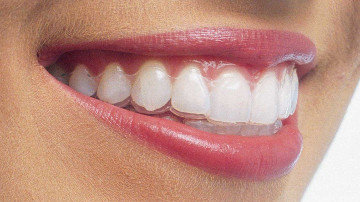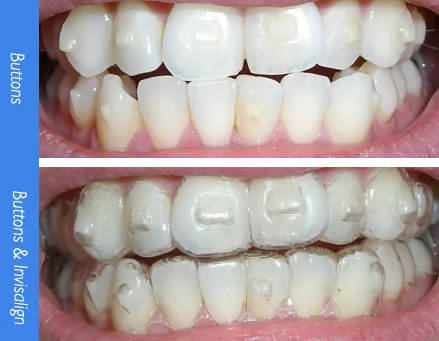Invisalign vs. Standard Braces: Which Choice Is Right for You?
When thinking about orthodontic therapy, the option between Invisalign and typical braces offers a number of important aspects that merit cautious assessment. Invisalign supplies a discreet choice with removable aligners, while standard braces supply a more visible yet reliable service for extreme misalignment. Each choice encompasses unique benefits and downsides connected to aesthetics, comfort, therapy duration, and price. Recognizing these nuances is essential for making an educated decision that lines up with your personal choices and way of life. The concern stays: which option will ideal meet your orthodontic requirements and expectations?
Introduction of Therapy Alternatives

In comparison, conventional braces contain steel brackets and wires that are bound to the teeth. This approach applies constant stress with time to achieve positioning. While reliable for complicated orthodontic issues, traditional braces require routine gos to for changes and can pose difficulties in preserving dental health because of the trouble of cleaning about brackets and wires.
Both choices have their qualities, and the choice frequently depends upon details oral problems, way of living choices, and person conformity. Ultimately, getting in touch with an orthodontic specialist is essential for establishing one of the most ideal therapy plan tailored to private requirements. Comprehending the nuances of each choice can dramatically affect the total success of orthodontic treatment.
Aesthetic Considerations
A considerable element influencing the option between Invisalign and traditional braces is the visual allure each therapy uses. Invisalign aligners are crafted from clear plastic, making them essentially unnoticeable when worn. This discreet appearance is particularly appealing to teens and adults that might really feel awkward regarding their orthodontic treatment. The capacity to keep an all-natural smile throughout the positioning procedure can dramatically boost the individual's self-confidence in expert and social settings.
In comparison, conventional dental braces include steel brackets and cords, which can be more obvious. While innovations in orthodontic modern technology have caused the growth of smaller brackets and tinted elastics, typical braces still preserve a more conspicuous profile. For some people, the presence of braces may prevent them from looking for necessary treatment.
Eventually, the selection in between Invisalign and traditional braces might depend upon individual preferences pertaining to aesthetics. Individuals that prioritize discernment frequently favor Invisalign, while those that are much less worried regarding presence might select conventional braces. Comprehending the visual effects of each option is important for making an educated choice that straightens with one's way of living and choices.
Convenience and Convenience

In regards to comfort, Invisalign aligners are detachable, enabling clients to enjoy their favorite foods without restriction and maintain great site optimal dental health. Cleaning and flossing are simplified, as the aligners can be gotten during these routines, whereas traditional dental braces call for mindful navigating around braces and wires.
In comparison, conventional dental braces require regular changes, making them less hassle-free for those with busy timetables. Generally, the comfort and convenience of Invisalign make it an enticing choice for several individuals seeking orthodontic therapy.
Therapy Duration and Efficiency
While both Invisalign and conventional dental braces are efficient in dealing with dental misalignments, the period of treatment can vary considerably in between the two alternatives. Normally, Invisalign treatment can take anywhere from 12 to 18 months, relying on the intricacy of the case. The clear aligners function by slowly shifting teeth right into their preferred positions, and routine follow-ups with an orthodontist aid guarantee development continues to be on the right track.
In comparison, traditional dental braces frequently need a longer commitment, typically ranging from 18 months to 3 years. This is due to their fixed nature and making use of cords and braces, which can be more reliable for complicated cases and severe imbalances (Invisalign). read this post here The therapy efficiency of typical dental braces is well-documented, as they enable specific changes and better control over tooth activity
Inevitably, the selection in between Invisalign and standard dental braces may hinge on both the anticipated treatment period and the details oral concerns available. Consulting with an orthodontist is vital, as they can give customized suggestions based on individual demands, ensuring the picked approach lines up with desired durations and results.
Expense Comparison and Insurance Coverage Options
Cost plays a significant duty in the decision-making procedure for individuals considering orthodontic therapy, whether selecting Invisalign or conventional dental braces. Typically, the cost of Invisalign arrays from $3,000 to $8,000, while standard braces typically set you back between $2,000 and $6,000. Variables influencing these prices include the intricacy of the situation, the period of therapy, and geographical location.
Insurance policy coverage can considerably impact out-of-pocket costs. Numerous oral insurance coverage strategies supply partial coverage for orthodontic therapies, but the specifics can differ widely. It is crucial for patients to evaluate their insurance coverage to establish the extent of protection for either alternative. Typically, typical braces may be extra frequently covered by insurance coverage strategies compared to Invisalign, which some insurance firms categorize as a cosmetic procedure.
In addition, several orthodontic practices provide versatile repayment plans, making both treatment choices a lot more obtainable. People need to ask about possible funding alternatives and price cuts for ahead of time settlements. Reviewing the complete expense, including insurance coverage benefits and layaway plan, is essential for making an educated choice that lines up with both aesthetic preferences and budget factors to consider.

Verdict
In summary, the selection between Invisalign and typical braces pivots on multiple variables, including visual preferences, comfort, therapy duration, and expense. Invisalign offers a very discreet, detachable choice that facilitates oral health and dietary versatility, while typical braces might be preferable for intricate dental problems and usually come at a reduced rate point. Eventually, appointment with an orthodontist is vital to examine specific situations and figure out the most proper therapy alternative for achieving optimal dental positioning.
When taking into consideration orthodontic therapy, the choice between Invisalign and conventional braces offers numerous important elements that merit cautious analysis.Contrasting Invisalign and typical braces reveals unique therapy choices for orthodontic improvement.While both Invisalign and traditional braces are effective in fixing oral imbalances, the period of treatment can vary significantly in between the 2 choices.Expense plays a considerable role in the decision-making process for people considering orthodontic therapy, whether deciding for Invisalign or typical dental braces.In summary, the choice between Invisalign and typical dental braces hinges on multiple factors, consisting of visual preferences, convenience, therapy duration, and cost.